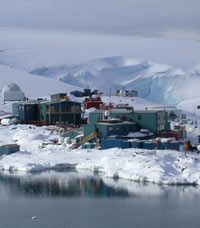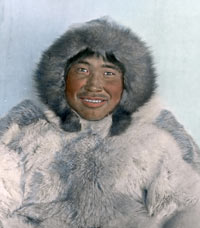Compare the Poles: Human Impact
Antarctica: Science Stations |
The Arctic: Native people |
|
|
Antarctica has no government and belongs to no country |
Arctic nations include: Canada, Greenland (a territory of Denmark), Russia, United States (Alaska), Iceland, Norway, Sweden, and Finland. |
There are no permanent residents at 60°S, but there is a sparse population (1,000 in winter to 4,000 in summer) at various scientific stations |
Human population north of 60°N is in excess of 4 million with modern settlements |
First crossing of the Antarctic Circle was by James Cook on January 17, 1773 |
The first crossing of the Arctic Circle is prehistoric |
Indigenous people
 View a slideshow of an Inuit Village
View a slideshow of an Inuit VillageSeven men in an early 20th century Arctic expedition lived in a house they built in the village of Etah, a settlement of about two dozen Inuit men, women, and children located in northern Greenland.
Everyone is familiar with the polar bear as an icon of the north, but did you know that 4 million people live in the Arctic? The Arctic has an undeserved reputation as being a desolate, lifeless, inhospitable place. In fact, the Arctic regions of Alaska, Canada, Greenland, northern Scandinavia and Siberia are the home for a number of indigenous peoples. Over thousands of years, Arctic peoples have adapted to their environment, subsisting on the bounty of land and sea, to live and prosper.
Arctic settlements are varied—there are a few industrialized cities and a great number of small communities. Most of the towns are strategically located near migration routes and food sources. For example, the town of Barrow, Alaska is located at the northern tip of Alaska, on the coast where hunters can find bowhead whales as they migrate from the Arctic to the Pacific.
In contrast, there are no indigenous people of Antarctica. A number of scientific bases are staffed through the summer and winter, but there is no government in Antarctica.
Harvesting from the sea
When early Arctic and Antarctic explorers returned home and described the abundance of seals and whales they had seen, sealers and whalers were drawn to these new waters to hunt the valuable animals. Hunting was so intense that some species were driven nearly to extinction, and sealing and whaling slowed down only when there were too few left to make the hunts profitable. Agreements among nations now protect most seals and whales limiting how many can be killed.
Populations of most Antarctic seal species have increased dramatically. Most whale species, though, still number fewer than they once did, and some nations continue whaling in polar waters. Today, the bowhead whale is the only truly endangered Arctic mammal.
Harvesting from the land
There are no terrestrial mammals in the Antarctic, but the Arctic has plenty of mammals, including musk ox, reindeer, caribou, fox, hare, wolf, lemming, bears, and more.
The Inuit of the historical era have largely been dependent on mammals for warm clothing. Caribou killed in August, when the new hair is still short and fine, provided the most popular clothing skins. Musk ox robes and skins of caribou killed in winter were used for bedding.
With social and industrial development, conservation of Arctic fauna has demanded increased attention. Recent developments include restrictions by the US on the import of sea mammal products; imposition by the International Whaling Commission of quotas on the take of bowheads by Alaskan native hunters; signing of an international convention on the conservation of the polar bear (particularly on the high seas) by the US, Norway, Denmark, Russia and Canada; and the devolution of game management authority to Canadian Inuit organizations after land claim settlements.
Other threats to Arctic animals may include the impact of pollution (industrial and military) from the south on more fragile ecosystems, and more harvesting pressure as human populations grow.



